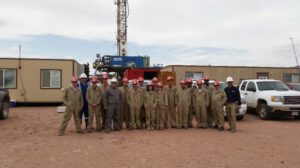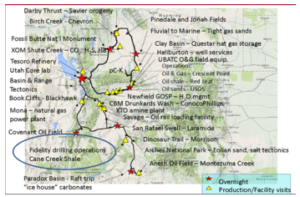During the summer semester of 2014 University of Utah MS Petroleum Engineering students visited 14 engineering operations and facilities. The goal was first hand exposure to oil and gas operations in Utah and Wyoming. Following a tour of Savage Services’ rail transloading facility [link], students toured a Fidelity Exploration & Production Company drilling location. This drilling operation targeted the Cane Creek shale play. The drilling location was near Moab, UT. Fidelity has been operating in Utah’s Paradox Basin since 2007, an area known for its complex geology and liquids-rich production.  Fidelity has successfully explored in this complex geology regime. Students in the field study received a detailed safety orientation before touring a Triple AC rig being used to drill extended laterals in the Cane Creek shale formation. This difficult but productive shale has led to several prolific wells. In fact, wells have been able to produce naturally, without fracture stimulation. Students were also introduced to the challenges of production in such a remote area. Fidelity has effectively been working with federal agencies and local communities to balance impact from its E&P operations with the tourism and the wilderness qualities of these areas. Fidelity’s operation underscores how energy companies can effectively engage stakeholders to achieve mutual benefits.
Fidelity has successfully explored in this complex geology regime. Students in the field study received a detailed safety orientation before touring a Triple AC rig being used to drill extended laterals in the Cane Creek shale formation. This difficult but productive shale has led to several prolific wells. In fact, wells have been able to produce naturally, without fracture stimulation. Students were also introduced to the challenges of production in such a remote area. Fidelity has effectively been working with federal agencies and local communities to balance impact from its E&P operations with the tourism and the wilderness qualities of these areas. Fidelity’s operation underscores how energy companies can effectively engage stakeholders to achieve mutual benefits.  Over the course of the field study, students encountered a diverse range of petroleum-related operations. These encompassed E&P operations, midstream and downstream facilities, as well as end-use applications. Students also met with service providers and recruiters. The Department of Chemical Engineering was fortunate to work with many of Utah and Wyoming’s key energy companies; including ConocoPhillips, XTO, Savage Energy Services, Fidelity, Resolute, Wolverine, PacifiCorp, Utah Geologic Survey, Tesoro, Newfield, Crescent Point, Red Leaf, U.S. Oil Sands, Halliburton, Questar, and ExxonMobil. Each organization’s willingness to showcase their work and their facilities offered our students a unique opportunity to understand the full life-cycle of hydrocarbon commodities and highlighted potential career paths.
Over the course of the field study, students encountered a diverse range of petroleum-related operations. These encompassed E&P operations, midstream and downstream facilities, as well as end-use applications. Students also met with service providers and recruiters. The Department of Chemical Engineering was fortunate to work with many of Utah and Wyoming’s key energy companies; including ConocoPhillips, XTO, Savage Energy Services, Fidelity, Resolute, Wolverine, PacifiCorp, Utah Geologic Survey, Tesoro, Newfield, Crescent Point, Red Leaf, U.S. Oil Sands, Halliburton, Questar, and ExxonMobil. Each organization’s willingness to showcase their work and their facilities offered our students a unique opportunity to understand the full life-cycle of hydrocarbon commodities and highlighted potential career paths.